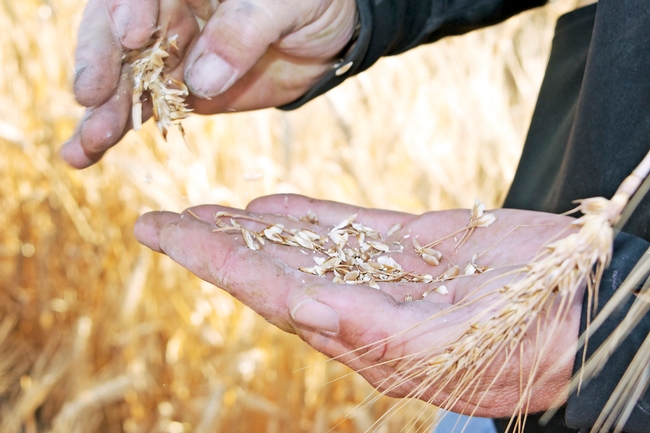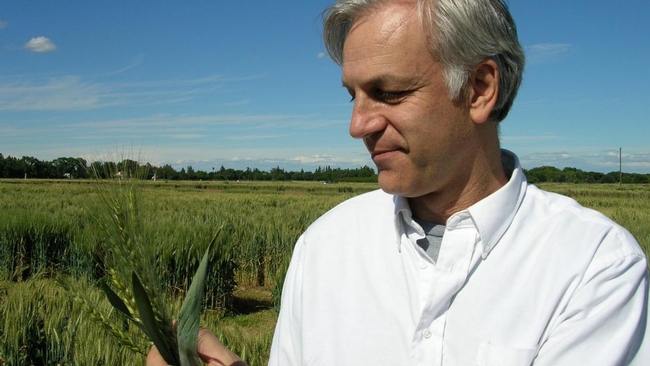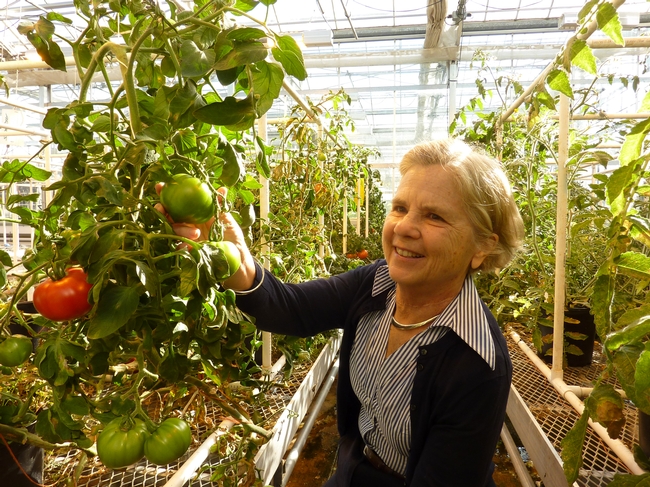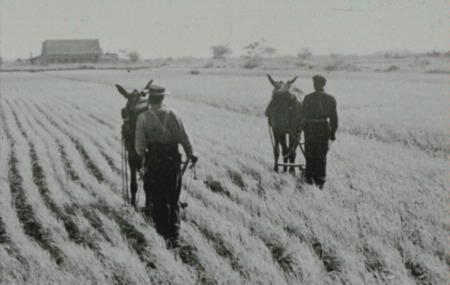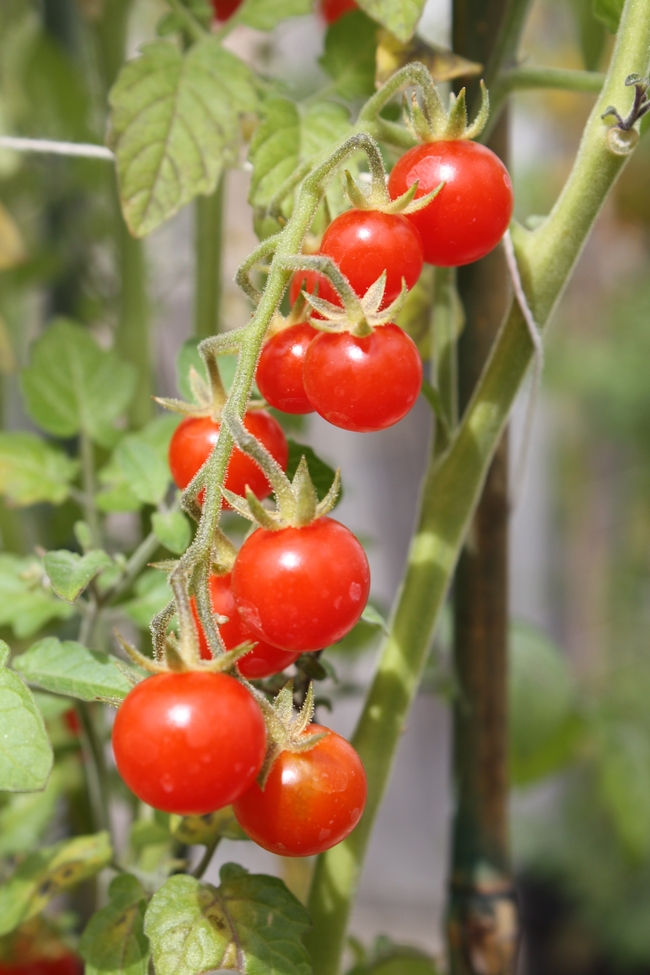Posts Tagged: genetics
UC Davis team identifies wheat gene that increases yield
The findings could help growers produce more wheat without expanding operation
A team of scientists from University of California, Davis, have identified a new gene variant in wheat that can increase the amount of the grain produced, new research published in the journal PLOS Genetics finds.
Wheat is a staple of food diets worldwide and the gene discovery could allow farmers to grow more food without increasing land use. Increased yield could also lower consumer prices, making the crop more accessible.
“We have a growing human population that likes to eat every day,” said Jorge Dubcovsky, a plant sciences distinguished professor who led the research. “We need to produce more wheat in the same space so we need plants that are more productive.”
The researchers found a gene – WAPO1 – that controls the maximum number of grains in a wheat spike. Breeding the beneficial gene variant into the plants could delay the formation of the terminal spikelet, providing room for more grains to grow in each spike rather than ending production of grain.
WAPO1 is one of the first genes discovered that can affect wheat yield. “We are trying to make more productive wheat varieties and we are starting to understand how that trait is controlled,” Dubcovsky said.
Pasta wheat lacking the gene
The gene variant for high grain number is found frequently in bread wheats but not in pasta wheats. By breeding the beneficial gene variant into those pasta wheat varieties, growers could increase yield by 4% to 5% in cultivars that have the biomass capacity to fill the extra grains.
“We developed molecular markers to select for the form of that gene to produce increased yield,” Dubcovsky said. “It's a significant step forward.”
Previous research by the team mapped the gene and identified others that could affect yield. This research confirmed those findings for WAPO1.
Discovery on path to future yield increases
The WAPO1 gene is part of a network of genes that work together to control yield, and researchers need to identify the best variant combinations to maximize yield. Solving this puzzle can lead to better production rates.
“We will continue to try to understand the network of genes that control the yield of wheat,” he said.
Saarah Kuzay, Huiqiong Lin, Chengxia Li, Shisheng Chen, Daniel P. Woods and Junli Zhang from UC Davis also contributed to the research, as did scientists from Howard Hughes Medical Institute, Heinrich Heine University and Peking University Institute of Advanced Agricultural Sciences.
Funding was provided by USDAs National Institute of Food and Agriculture's Food Research Initiative, the International Wheat Yield Partnership and Howard Hughes Medical Institute.
Discovery could deliver vintage flavor to a tomato near you
People often complain about grocery store tomatoes, saying they’re too hard and don’t have the flavor we remember from the days of old. And we thought we knew why - because the millions of tons of tomatoes harvested in the United States and beyond have to be picked before they’re fully ripe and juicy in order to survive being shipped long distances. What’s more, many shoppers store their tomatoes in the fridge, which destroys both their flavor and texture.
But guess what? It’s not just how tomatoes are grown, harvested and stored that affect their flavor. A research team led by Ann Powell, a biochemist in the UC Davis Department of Plant Sciences, has discovered a gene mutation that diminishes a tomato’s flavor even if the fruit is picked ripe and stored well. The finding, which was reported in the June 29 issue of the journal Science, identifies a gene that was unknowingly bred out of modern cultivated tomatoes and plays a vital role in producing the sugars and aromas that make heirloom tomatoes so tasty.
The news is unexpected and encouraging, because now breeders have the genetic information they need to create modern varieties suited for large-scale harvest and shipping with all the flavor of more delicate heirloom varieties.
“Now that we know that some of the qualities that people value in heirloom tomatoes can be made available in other types of tomatoes, farmers can have access to more varieties of tomatoes that produce well and also have desirable color and flavor traits,” Powell said.
It takes awhile to breed a new tomato variety, so don’t expect to taste the results anytime soon. But Powell and her team’s discovery is a huge first step. Tomato lovers can also be grateful for C.M. Rick Tomato Genetics Resource Center at UC Davis, home to a vast collection of mutant and wild species of tomatoes which provides the genetic diversity scientists and breeders need to recapture the flavor of old.
You can read more about the study here.
You can access the Science article here.
You can learn more about the C.M. Rick Tomato Resource Center here.
Were those the days?
To the tune of Mary Hopkin's iconic 60s hit, Those Were the Days, a team of UC animal scientists ask whether those bygone times people remember nostalgically would be up to the challenge of feeding the world today.
"People have a romantic image of farming in the past," said Alison Van Eenennaam, UC Cooperative Extension specialist in the UC Davis Department of Animal Science. "It may be remembered as bucolic, but there wasn't enough food being produced to cope with world population growth."
Van Eenennaam, an expert in animal genomics and biotechnology, rewrote the song and posed the question, Were those the days?, with historical photos of Americans hand-milking cows one by one, preparing a field with a horse-drawn plow and tossing out handfuls of chicken feed from a bucket.
Van Eenennaam's remake declares,
Those were long days, my friend
We thought they'd never end
We'd plow and toil forever and a day
It's not the life we'd choose
We'd work and never snooze
Those were hard days, oh yes, those were hard days.
Interspersed in the video are statistics that reveal how far modern agriculture has come. For example, the U.S. dairy cattle population peaked at 25.6 million animals in 1944. By 1997, improved dairy management and genetics increased milk production per cow by 370 percent, reducing by more than half the number of dairy cows needed to provide milk for U.S. consumers.
The video notes that, in 1923, it took about 112 days to produce a broiler chicken. In 2000, a much larger chicken is produced in 48 days.
"If you're going to expend resources feeding and housing a happy cow," Van Eenennaam said, "it stands to reason that feeding an efficient, high-producing cow decreases the amount of feed required and waste generated per glass of milk or pound of beef."
Van Eenennaam’s video production is competing in a contest sponsored by the American Society of Animal Science. The video that gets the most “likes” on YouTube before June 1 receives a cash prize and will be shown at the American Society of Animal Science meeting in Phoenix. See the video below, but go to YouTube and sign into your Gmail or YouTube account for your “like” to count.
I say tomato!
Here we are, a month into summer, and one of my favorite fruits is starting to emerge: Luscious tomatoes, fresh off the vine.
I know, most of us treat tomatoes like a vegetable in the kitchen, slicing and dicing them into dishes that are savory rather than sweet. Botanically speaking, tomato is a fruit because it’s developed from the ovary in the base of the flowers and contains the seeds of the plant (though cultivated forms may be seedless.)
No matter, the tomato is a nutritional powerhouse any way you cut it, loaded with vitamin C, vitamin A, potassium and lycopene, an antioxidant credited with preventing both cancer and heart disease.
The UC Davis Department of Plant Sciences devotes many resources to tomato production, helping large- and small-scale growers, organic and otherwise, control weeds, manage pests, fight disease and tackle all the other adventures farming can bring. The department is also home to the C.M. Rick Tomato Genetic Resource Center, the largest known collection of tomato seeds in the world. You can’t breed a better tomato without diversity of genetic tissues, and the repository and its abundance of wild species are the sources of resistance to 44 major tomato diseases and at least 20 insect pets – not to mention improved fruit traits like tolerance to saline conditions and drought.
Of course, growing or buying a tomato is only part of the equation. How do you make sure the fruit of your labor is tasty and safe? Here are some helpful hints from the UC Davis Postharvest Technology Center, a handy resource for all your postharvest technology needs:
How to choose: A ripe tomato will be plump, vibrant in color and fairly firm to the touch. You want it to have a little give, but not much. Ageism aside, avoid a tomato with wrinkles.
How to store: Keep tomatoes at room temperature, away from direct sunlight, with the stem scar (the belly button, if you will) facing up to reduce softening and darkening of the fruit. It’s best to eat them within two or three days, though some tomatoes are perfectly fine for about five days. Store tomatoes unwashed and then rinse them under running water before eating.
How to prepare: After rinsing your tomato well, wipe it dry and cut away the stem scar and surrounding area before slicing into it. Don’t wash tomatoes in a sink filled with water (nor use soap or detergent) because tomatoes can absorb contaminated water and soap residue through its stem scar. Cut or chopped tomatoes (and dishes like salsa) should always be covered and refrigerated if not consumed within two hours or preparation. Cut tomatoes will last one or two days in the refrigerator.
How to enjoy: Enjoy them every which way! It would be hard pick my favorite tomato recipe, but you can’t go wrong with this fast, fresh salad:
Tomato platter special
Four fresh tomatoes of any color or variety
Two red onions
Two orange, yellow or red bell peppers
A few sprigs of basil
Your favorite vinaigrette
Four ounces Feta cheese
Slice the produce into circles and fan them out on a platter in an attractive, alternating order. If you have fresh cucumbers, they fit nicely in this flower, as well. Drizzle with vinaigrette, crumble on some Feta cheese, give a few grinds of fresh pepper and few shakes of salt and place basil sprigs on top.
Delish.
You can read more tomato tips from the Postharvest Technology Center here and explore many more of their practical publications here.
It's a fruit...It's a mandarin...It's ‘KinnowLS’!
On the Jeopardy show, the clues could easily be: “It’s new and attractive. It’s juicy and sweet. And it’s low-seeded and peels easily.”
To which the answer would be, “What is ‘KinnowLS’?”
‘KinnowLS’ – the LS is short for low seeded – is the latest citrus variety released by researchers at the University of California, Riverside.
Large-sized for a mandarin, the fruit has an orange rind color. The rind is thin and extremely smooth. The 10-11 segments in each fruit are fleshy and deep orange in color.
‘KinnowLS’ matures during February through April, and does well in hot climates. It was developed by mutation breeding of the mandarin cultivar ‘Kinnow,’ a mid-to-late season maturing variety developed by UC Riverside nearly 100 years ago. While ‘Kinnow’ has 15-30 seeds per fruit, ‘KinnowLS’ has only 2-3 seeds per fruit.
“People who like very sweet fruit are going to find ‘KinnowLS’ to be very appealing,” says Mikeal Roose, a professor of genetics, who developed ‘KinnowLS’ along with staff scientist Timothy Williams. “When other citrus varieties mature to reach the level of sweetness of ‘KinnowLS,’ their other qualities – such as rind texture – are in decline. Neither ‘Kinnow’ nor ‘KinnowLS’ suffer in this way.”
Yet another attractive quality of ‘KinnowLS’ is that it can be grown in California’s desert regions because the fruit, which matures during February through April, does well in hot climates.
Indeed, ‘Kinnow’ is the most important mandarin in the Punjab regions of India and Pakistan, where ‘Kinnow’ fruit trees constitute about 80 percent of all citrus trees.
“But the fruit, which is popular there, is seedy,” Roose says. “Therefore, ‘KinnowLS’ has very good potential in this area of the world.”
Growers in India and Pakistan will have to wait a few years, however, before ‘KinnowLS’ trees can strike roots there. Currently, plans are to distribute ‘KinnowLS’ budwood, starting this month, to only licensed nurseries in California. (For three years, only California nurseries will be permitted to propagate ‘KinnowLS.’ Licenses for ‘KinnowLS’ propagation outside the United States will be issued thereafter.)
So when will we find ‘KinnowLS’ in U.S. produce aisles?
Alas, not for at least five years. It generally takes about that long to propagate citrus trees.
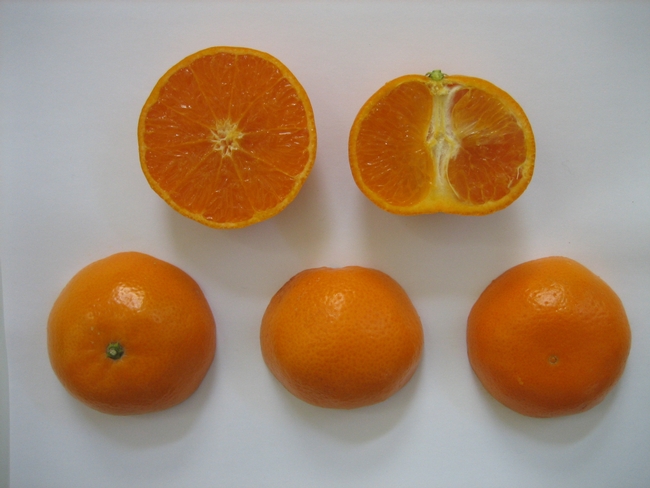
2602 1hi


